Technology
Genius Sports Reports Strong Q1 2025 Financial Results
Genius Sports Limited ( (GENI) ) has provided an announcement. On May 6, 2025, Genius Sports Limited released its interim financial report for the first quarter of 2025, showing a significant increase in revenue to $143.991 million compared to $119.718 million in the same period last year. The company’s gross profit also rose markedly, reflecting […]

Genius Sports Limited ( (GENI) ) has provided an announcement.
On May 6, 2025, Genius Sports Limited released its interim financial report for the first quarter of 2025, showing a significant increase in revenue to $143.991 million compared to $119.718 million in the same period last year. The company’s gross profit also rose markedly, reflecting its strengthened market position and operational efficiency. This financial performance underscores Genius Sports’ growing influence in the sports data and technology sector, potentially benefiting stakeholders through increased shareholder value and market competitiveness.
Spark’s Take on GENI Stock
According to Spark, TipRanks’ AI Analyst, GENI is a Neutral.
Genius Sports Limited demonstrates strong revenue growth and cash flow improvements, positioning it well for future profitability. The positive momentum in technical analysis and robust earnings call guidance further bolster the stock’s outlook. However, persistent net losses and a negative P/E ratio indicate valuation concerns. The company’s ability to translate revenue growth into sustainable profitability remains a key challenge.
To see Spark’s full report on GENI stock, click here.
More about Genius Sports Limited
Genius Sports Limited operates in the sports data and technology industry, providing data management and integrity services to sports leagues, media companies, and sportsbooks globally. The company focuses on delivering real-time data and technology solutions to enhance fan engagement and sports integrity.
YTD Price Performance: 29.53%
Average Trading Volume: 3,588,657
Technical Sentiment Signal: Sell
Current Market Cap: $2.85B
Learn more about GENI stock on TipRanks’ Stock Analysis page.
Disclaimer & DisclosureReport an Issue
Technology
How Fan Engagement Is Evolving with Tech
In Japan, sports have long been tied to ritual, community, and tradition—from sumo stables to packed J.League stadiums. Today’s fans expect much more than just attending a match. They demand participation, interaction, access, backend glimpses, and real-time insights into the event. Digitalization of the sports industry is changing the traditional ways of defining fan engagement. […]
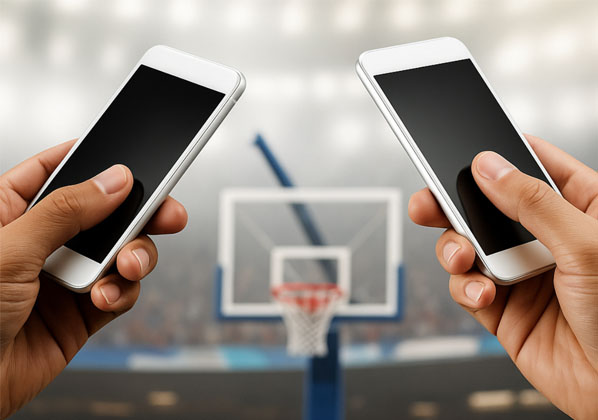

In Japan, sports have long been tied to ritual, community, and tradition—from sumo stables to packed J.League stadiums. Today’s fans expect much more than just attending a match. They demand participation, interaction, access, backend glimpses, and real-time insights into the event. Digitalization of the sports industry is changing the traditional ways of defining fan engagement.
Due to technology, not only the broadcasting of games, but also how players, teams, and even other spectators interact, is experiencing a shift. The smartphone, social media, and even the internet have turned into hubs of spending spare time, and the sports industry is investing in immersive apps that take the audience as close to the action as possible.
Interactive Viewing and Second-Screen Experiences
The rise of second-screen culture—where fans engage with content on phones or tablets while watching a game—has dramatically reshaped live sports. Broadcasters and clubs are now enhancing match feeds with live stats, polls, and fan chats. This multilayered experience is designed to deepen emotional connection while extending the time fans spend interacting with their brand. Innovations related to sports betting online, integrated into match-day dashboards, often mirror the same real-time responsiveness expected by modern viewers.
Japan has begun integrating fan voting during live contests, augmented reality replays, and changing commentary audio streams for companion apps within its professional baseball and soccer leagues. For example, NHK and DAZN Japan offer multi-angle viewing and a strategy breakdown offering. Transforming from a passive observer to an active participant is most remarkable in the case of sports technology.
Key Technologies Driving Engagement
As platforms and franchises strive to maintain engagement amidst growing competition, they are adopting new technology. Perpetual engagement and fandom retention are not, and never have been, new concepts. Remember that as we go over the list.
Important developing technologies altering fan interaction:
- Augmented Reality (AR): Used in stadiums and mobile apps to display stats or player animations
- Virtual Reality (VR): Allows users to “attend” matches through headsets from the comfort of their home.
- NFTs and Digital Collectibles: Grant fans one-of-a-kind assets that are bonded to their favorite teams
- Gamification: Encourages sustained engagement by embedding trivia, forecasts, and other forms of challenges into apps
- AI-Powered Chatbots: give fans instant messaging updates and tailored information using chat applications
Focusing on Japan’s metropolitan areas, where users depend on mobile devices for information and leisure, these tools are extremely pertinent. The combination of entertainment with gaming, as well as sports, is a reasonable progression.
The Role of Social Platforms and User-Generated Content
On TikTok and X (previously Twitter), the content created by ‘normal’ users is being compared to gameday highlights, reactions, and analyses provided by official accounts as they draw similar amounts of attention. In response to this, Japanese teams have changed their policy to simple creation response via a branded hashtag, retweets, and even contests for branded viral content.
Notable esports leagues based in Tokyo offer regular fan shoutouts and also allow active followers to vote on various aspects of the games like team kits and some rules of engagement. These forms of participation, however minimal, support a never-ending exchange between the fans and the organizers. This phenomenon has shifted to be essential to modern fan loyalty.
The effect of gamified design is more noticeable because of online casino slots. Trivia games with ‘spin to win’ mechanics or locked content are commonplace within mobile apps, gaining popularity among beginners which keeps them engaged long after the game is over. These systems encourage a seamless and addictive pattern idealized for daily competition among friends to gain the upper hand, similar to mobile games.
Case Study: J.League’s Fan-Centric Innovations
The J.League has led in connecting with fans digitally across Asia. In 2023 it joined forces with Yahoo Japan and Rakuten to implement a new system where fans can choose “Player of the Match” in real-time during the matches. Votes affect social media activity, discounts on merchandise, and several other engagements including meet-and-greets.
In a separate pilot program, fans wearing smartbands were able to receive haptic feedback synced with game events—buzzes and vibrations that mirrored a goal, a red card, or a substitution. The aim was to make fans feel connected to the action even if they weren’t physically in the stadium.
This model aligns with Japan’s larger smart city ambitions, where personalized digital experiences are integrated across services, from sports to public transit.

Fan Data and Personalized Experiences
All of the novel forms of engagement are collecting unprecedented volumes of information regarding fan behaviors. Currently, AI systems are evaluating this information to generate custom content proposals, bespoke merchandise recommendations, or adjust application features to the user’s behavioral routines. In Japan, where the culture emphasizes meticulousness, data-driven engagement is fostered and deeply effective.
Used by teams in Tokyo, SmartVenue and FanWise possess agile analytic features that segment fans into various activity levels, purchase history brackets, and content preferences. Teams can then deliver targeted notifications, such as birthday discounts, favorite player stats, or live alerts for local games.
As a result, each individual feels appreciated. Now it’s not about the largest crowd, but the most active crowd. It’s not about having the biggest crowd anymore—it’s about having the most engaged one.
Table: Evolution of Fan Engagement Technology
| Era | Key Tools & Methods | Fan Experience Impact |
| Pre-2010 | Traditional broadcast, physical merch | Passive viewing, limited feedback |
| 2010–2020 | Mobile apps, social media | Multi-screen interaction, online communities |
| 2020–Present | AR/VR, AI, NFTs, smart wearables | Real-time feedback, personalized engagement |
What’s Next for Japanese Sports Fans?
The growth of esports in Japan, along with its participation in international tournaments, signals a tech-enabled evolution in fan engagement. Once complete, 5G networks and AI technologies will deliver even more features to fans, including real-time immersion and interactivity.
In-stadium facial recognition systems could streamline access and concessions, while virtual commentators may adjust their style at home based on identified fan preferences. This is not science fiction; it is in progress through joint ventures between Japan’s sports federations and private innovators.
Shifts in culture are also changing the way sports and entertainment are consumed. Fans will engage with the brand far less through the game, but rather through their lives Woven with the digital matrix of existence.
Technology
Inside XbotGo’s NYC Showcase That Unveiled the Future of AI Sports Filming
What happens when one of the most talked-about names in sports tech brings its latest innovations to the heart of Manhattan? On April 18th, XbotGo answered that question with an exclusive live event at 135 Madison Avenue in New York City — unveiling major software upgrades to its flagship product, the XbotGo Chameleon, and offering […]
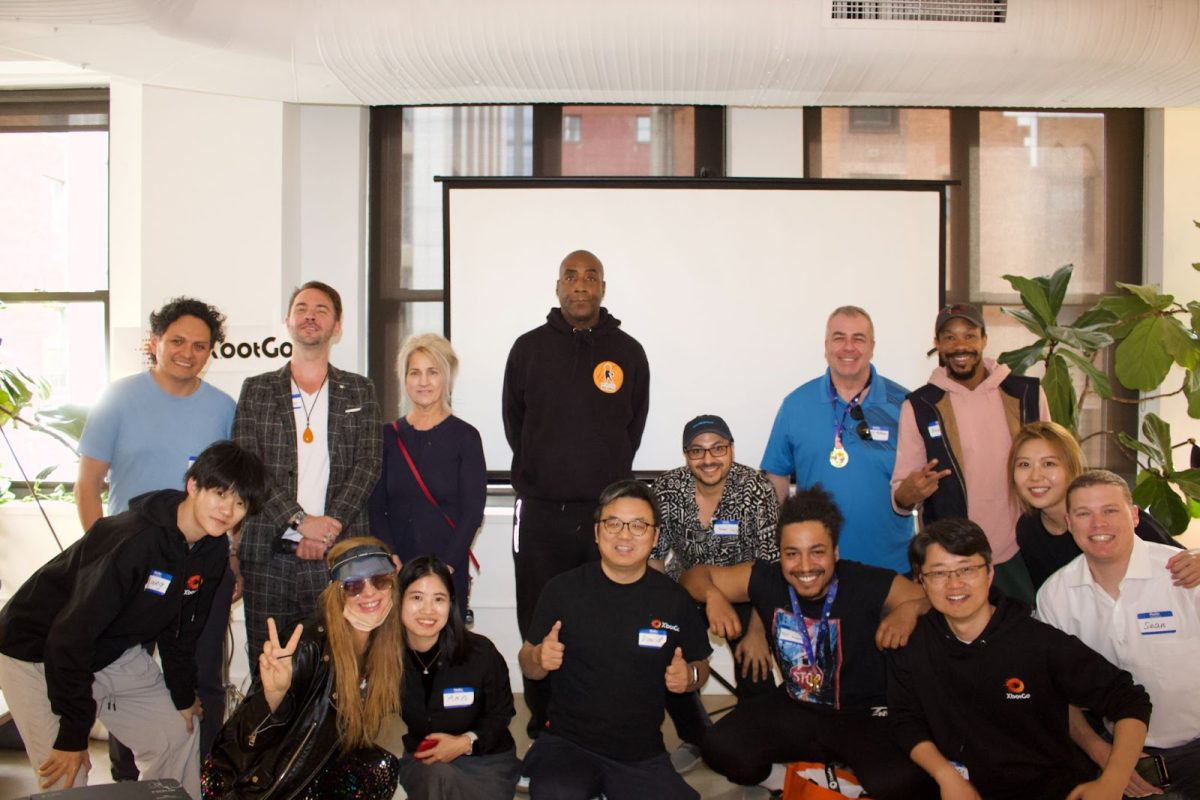
What happens when one of the most talked-about names in sports tech brings its latest innovations to the heart of Manhattan? On April 18th, XbotGo answered that question with an exclusive live event at 135 Madison Avenue in New York City — unveiling major software upgrades to its flagship product, the XbotGo Chameleon, and offering a rare, hands-on look into the future of automated sports content creation.
The four-hour event drew athletes, coaches, tech creators, youth program directors, and even high school students, all curious to see how XbotGo democratizes high-end sports filming. It wasn’t just a product demo — it was a showcase of how AI and sports are merging to empower teams and individuals in ways that were previously out of reach.
A Leap Forward in AI Sports Capture
At the core of the event was the debut of XbotGo’s newest software upgrade — a feature-packed update that takes the already impressive Chameleon system to the next level. The upgrade introduced faster player tracking, improved jersey number recognition, real-time scoreboard overlays via ScoreSync, and upgraded video editing AI that turns raw footage into social-ready content in minutes.
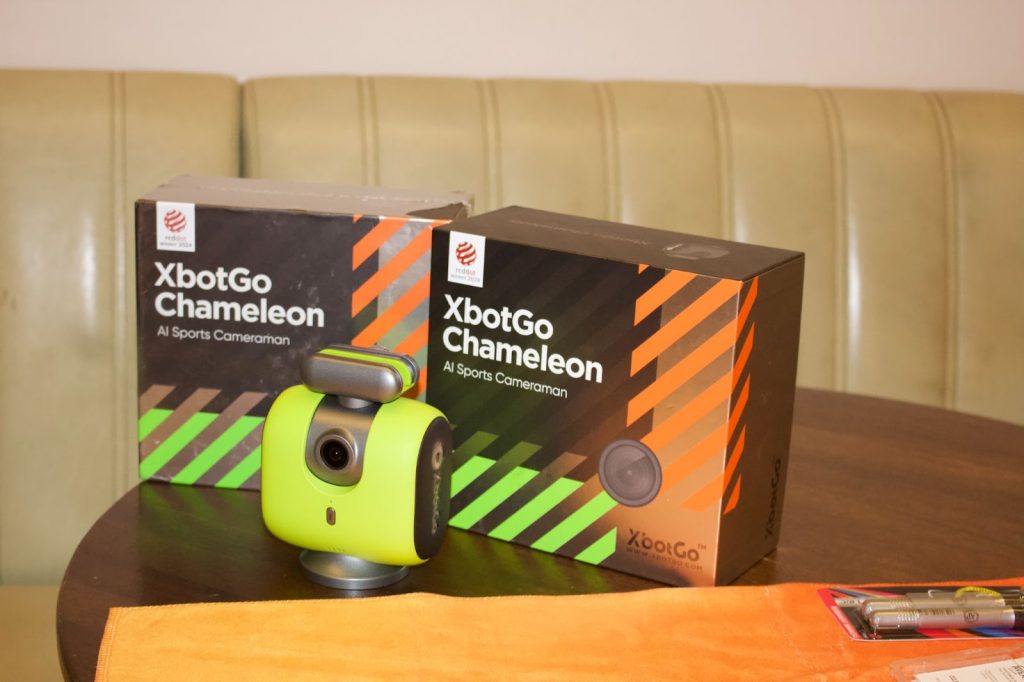
Basketball teams especially benefited from a new sport-specific algorithm that refines how the camera follows plays and isolates key moments. Attendees watched in real time as the system tracked players with 95% accuracy, panned smoothly across the court, and immediately tagged jersey numbers to auto-generate personalized highlights.
For teams lacking the resources to hire full-time videographers or editors, the implications were clear: this technology levels the playing field.

Behind the Scenes with the Visionaries
XbotGo Founder and CEO David opened the event with a keynote outlining the company’s journey—from early Kickstarter roots to national expansion—and the role customer feedback has played in shaping every update. He emphasized the mission behind the tech: giving more athletes and teams the power to control their own media presence, improve their performance, and share their stories with the world.
In a Q&A session, David fielded questions from athletes, coaches, and even content creators curious about integration with Apple Watch, the newly enhanced FollowMe Mode, and upcoming support for portrait video — a key request for TikTok and Instagram content.
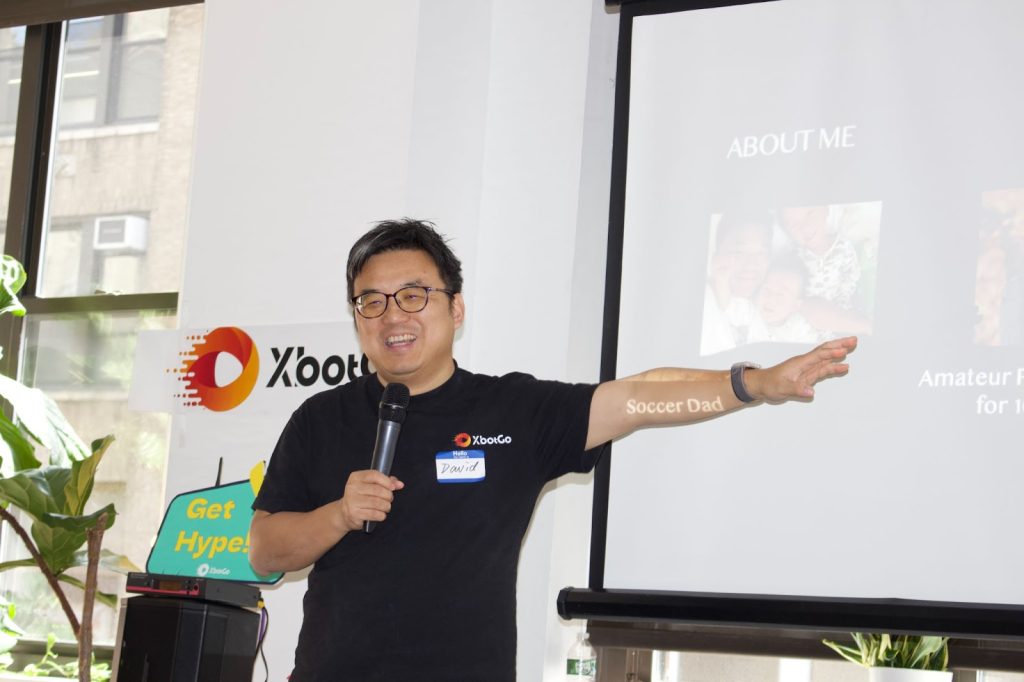
Stories from the Field
Throughout the afternoon, guests heard from actual users who brought the Chameleon into their training sessions, scrimmages, and tournaments. One youth basketball coach explained how he used the jersey tracking to build highlight reels for every player on his team—footage they later used in college recruitment outreach. A parent showed off a video of her daughter’s soccer goal captured in full 4K from a game she filmed solo, without touching the camera once.
These personal stories reinforced what the specs already showed: this isn’t just gear for elite athletes — it’s built for real people, real games, and real growth.

Immersive Demos, Exclusive Swag, and Community Vibes
XbotGo engineers guided small groups through interactive demos where guests tested the 120° field of view, 360° panoramic tracking, and T4 Tripod’s towering 13-foot height adjustment. Paired with Bluetooth remote control and Apple Watch syncing, the system proved how easy it was to go from setup to capture in under one minute.
Everyone left with limited-edition XbotGo merch, including a branded hoodie, cap, and microfiber towel. But more than the swag, the lasting impression was one of connection — between players and tech, creators and tools, and a growing community that wants to take game-day media into its own hands.
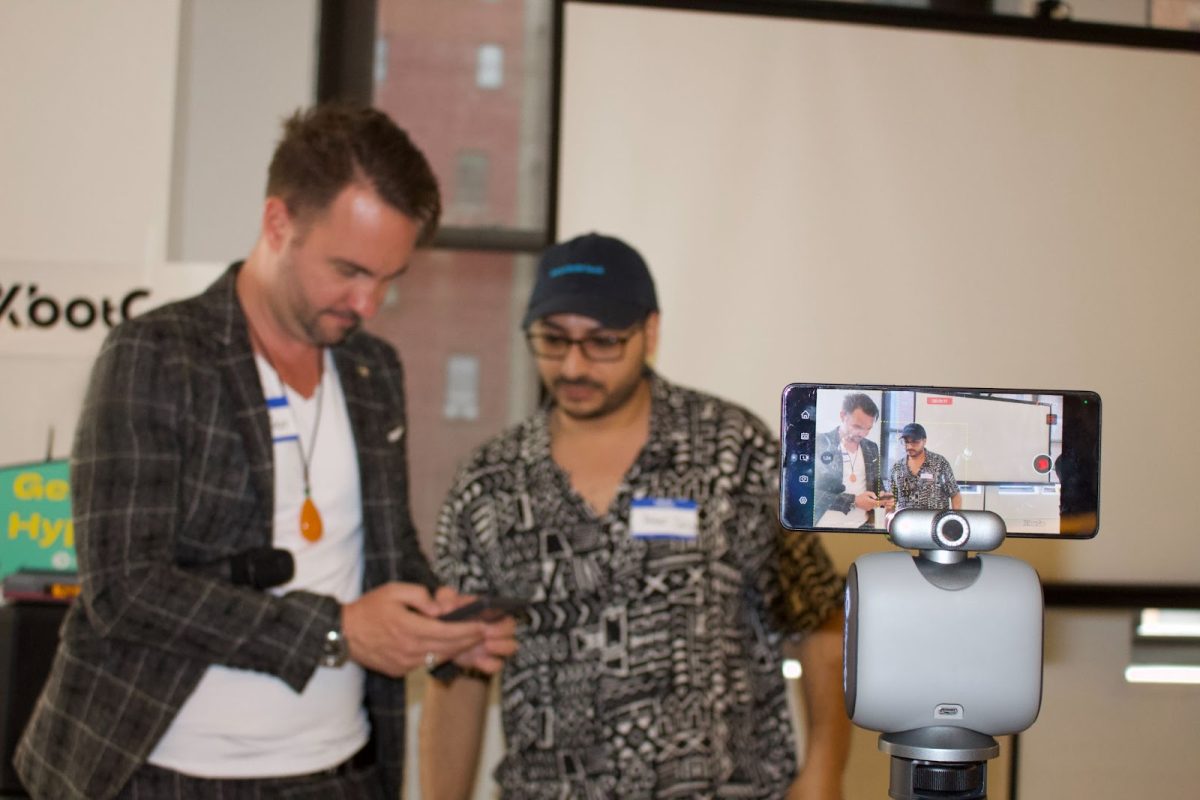
What’s Next for XbotGo
With more updates scheduled for late 2025, including portrait capture mode, multi-angle syncing, and AI commentary overlays, the NYC event was more than a celebration — it was a preview of a movement. XbotGo is positioning itself not only as a product brand but as an infrastructure for the future of sports storytelling.
Whether you’re a coach breaking down tape, a parent capturing milestone moments, or a creator building your sports channel, XbotGo Chameleon promises to turn your smartphone into a production studio — and your game into the show it deserves to be.
Learn more about the technology, watch sample footage, or order your system here.
Peter Salib is a Tech Columnist at Grit Daily. Based in New Jersey, he is an avid participant of events nationwide who’s attended CES in Las Vegas consecutively since 2013. Peter is the host and producer of Show & Tell, a product showcase YouTube channel and also works at Gadget Flow, a leading product discovery platform reaching 31M consumers every month. Peter frequently works with startups on media, content writing, events, and sales. His dog, Scruffy, was a guest product model on the Today Show with Kathy Lee & Hoda in 2018 and was dubbed “Scruffy the Wonder Dog.”
Technology
Disney is suing YouTube for poaching a key media and sports executive
Critically, Connolly leads the Disney team negotiating a license renewal with YouTube. Connolly has intimate knowledge of Disney’s other distribution deals, the financial details concerning Disney’s content being licensed to YouTube, and Disney’s negotiation strategies, both in general and in particular with respect to YouTube. It would be extremely prejudicial to Disney for Connolly to […]

Critically, Connolly leads the Disney team negotiating a license renewal with YouTube. Connolly has intimate knowledge of Disney’s other distribution deals, the financial details concerning Disney’s content being licensed to YouTube, and Disney’s negotiation strategies, both in general and in particular with respect to YouTube. It would be extremely prejudicial to Disney for Connolly to breach the contract which he negotiated just a few months ago and switch teams when Disney is working on a new licensing deal with the company that is trying to poach him.
Technology
The Sports Facilities Companies Expands Ice Portfolio with 13 New Ice Properties and Two Community Centers
SFC assumes management of 15 facilities in 11 states through agreement with Rink Management Services CLEARWATER, Fla., May 22, 2025 /PRNewswire/ — The Sports Facilities Companies (SFC), the nation’s leading manager of sports, recreation, and event venues, has expanded its ice rink portfolio by assuming management of 13 ice rinks across 11 states, plus two […]

SFC assumes management of 15 facilities in 11 states through agreement with Rink Management Services
CLEARWATER, Fla., May 22, 2025 /PRNewswire/ — The Sports Facilities Companies (SFC), the nation’s leading manager of sports, recreation, and event venues, has expanded its ice rink portfolio by assuming management of 13 ice rinks across 11 states, plus two additional community centers. The facilities, previously operated by Rink Management Services (RMS), will now benefit from SFC’s expertise in operations, programming, and community engagement. Through the agreement, RMS operational leadership and staff will transition into the SFC network, enhancing its capacity to manage and elevate ice rinks nationwide.
“SFC continues to expand our presence as a leader in ice rink management, and this is an exciting step in that journey,” said Jason Clement, CEO of The Sports Facilities Companies. “RMS has built a strong footprint in the industry, and by integrating their experience with our proven approach to operations and community service, we are enhancing our ability to deliver exceptional outcomes for athletes, guests, and the communities we serve.”
Under the leadership of President Tom Hillgrove, RMS will maintain a small portfolio of leased agreements while SFC assumes management of the acquired facilities. Moving forward, the two companies will collaborate on strategic opportunities.
“We are excited to see these facilities transition to SFC, a company with a proven track record of success in community-focused facility management,” Hillgrove said. “RMS will continue to operate independently with our leased agreements while working alongside SFC to further strengthen the ice rink industry.”
SFC’s expanded portfolio of ice facilities and community centers now includes the following facilities:
- Bryant Park Winter Village Ice Rink – New York, N.Y.
- Lloyd Center Ice Rink – Portland, Ore.
- Metro Park Toledo Glass City Ice & Roller – Toledo, Ohio
- Wichita Ice Center – Wichita, Kan.
- Parks Mall at Arlington – Arlington, Texas
- Ice Skate USA Memorial City – Houston, Texas
- Ice in Paradise – Goleta, Calif.
- Breslow Ice Hockey Center – Lincoln, Neb.
- Waconia Ice Arena – Waconia, Minn.
- Industry City Ice Rink – New York, N.Y.
- Elevance Health Rink at Bicentennial Plaza – Indianapolis, Ind.
- Washington Harbour Ice Rink – Washington, D.C.
- McCormick Tribune Ice Rink – Chicago, Ill.
As part of the deal, SFC will also take over management of multiple non-ice facilities, including the Romulus Athletic Center in Romulus, Michigan, and the Safari Island Community Center in Waconia, Minnesota.
“We are thrilled to bring these facilities into the SFC family and continue our momentum as a leader in ice rink management,” said Kelly Kryukov, senior vice president of ice venue operations at The Sports Facilities Companies. “Ice rinks serve as vital community hubs—whether it’s for youth hockey, figure skating, or public skating sessions. Our focus is on elevating these venues by enhancing programming, improving operational efficiency, and ensuring they remain accessible and welcoming spaces for all athletes and families.”
With this expansion, SFC now manages 20 ice rinks nationwide including two large multi-sport venues featuring ice surfaces and two rinks in New York City. For more information about ice rink operations at The Sports Facilities Companies, visit icerinks.com.
About The Sports Facilities Companies
The Sports Facilities Companies (SFC) is the nation’s leading resource for the management and development of sports, recreation, wellness, and events facilities. As a turn-key solution for community leaders and developers alike, SFC services span the gamut of sports and recreation needs from sports tourism & recreation master planning, program planning, and feasibility through professional facility management services. With over 90 managed venues and approximately 4,000 team members, represented by the SF Network, SFC welcomes nearly 30 million guest visits and produces almost $1 billion in economic impact each year. To learn more, please visit SportsFacilities.com and theSFnetwork.com.
Press Contact:
Ashley Whittaker
7274743845
http://sportsfacilities.com
SOURCE The Sports Facilities Companies

Technology
Blackbird backs Airwallex to fix its ‘most expensive’ mistake — Capital Brief
Australia’s largest venture capital firm has conceded that its investment in Airwallex’s US$300 million ($465 million) Series F round is a correction of a nine-year-old misstep. Blackbird passed on the Victorian startup in 2016, forcing Airwallex to turn to overseas investors for its first funding round. Blackbird doesn’t want to miss out again, tipping into […]

Australia’s largest venture capital firm has conceded that its investment in Airwallex’s US$300 million ($465 million) Series F round is a correction of a nine-year-old misstep.
Blackbird passed on the Victorian startup in 2016, forcing Airwallex to turn to overseas investors for its first funding round. Blackbird doesn’t want to miss out again, tipping into a pre-IPO capital raise that valued Airwallex at US$6.2 billion.
“We absolutely made a mistake not investing earlier,” said Blackbird partner Michael Tolo. “And it’s the most expensive one that we have made at Blackbird!”
“As in life, it’s less about the mistakes that you make and more about what you do to correct them. This round presented a rare moment for us to correct our previous mistakes and partner with one of the generational Australian companies.”
Technology
A Garmin Update Just Added Weighted Rucking to Instinct, Fenix, and Enduro Watches
We may earn a commission from links on this page. A new update to Garmin watches brings a rucking activity, with a pack weight setting, to the Instinct 3 (both regular and Tactical), the Fenix 8 series, and the Enduro 3. Rucking is also available at launch for the new Forerunners, the 570 and the […]

We may earn a commission from links on this page.
A new update to Garmin watches brings a rucking activity, with a pack weight setting, to the Instinct 3 (both regular and Tactical), the Fenix 8 series, and the Enduro 3. Rucking is also available at launch for the new Forerunners, the 570 and the 970. The same software update also brings breathing variation detection to a wide variety of watches, including Vivoactive, Venu, Lily, and Forerunner models.
Rucking—walking with a weighted pack—is both a fitness activity for people looking for a little exercise, and a necessity for many hikers and backpackers. But without a specific activity or pack weight setting, the only obvious way to track it was as a regular hike. Since you move slower when you’re carrying a heavy pack, that was impacting people’s VO2max scores—the watch thinks you’ve slowed down because you’re losing fitness.
The pack weight setting changes that. Besides the rucking activity, the running, trail running, hiking, and walking activities will all have this setting as well (on the supported watches I mentioned above, anyway). This lets you log today’s ruck as being done with a 15-pound pack, and tomorrow’s with a 10-pound pack, if those are the weights you’re carrying.
So far there’s no word on whether rucking or pack weights may be coming to other watches in the future. Older Forerunners, including the just-replaced 265 and 965, aren’t getting the new rucking features.
How to track rucking if your watch isn’t included in the update
If you have one of those older Forerunners, or another watch that doesn’t get rucking in this update, there is a workaround. As pointed out in this Reddit thread, you can create a Cardio workout. (Go to the More menu in Garmin Connect, then Training and Planning, then Create a Workout.)
What do you think so far?
Create one step in the cardio workout, and for that step, set the exercise to “Walk.” You’ll be able to add a weight. This activity won’t track your location with GPS—so it’s not a great option if you’re hiking in the wilderness or need to track your speed—but some users have found it helpful as a way to record pack weight and time rucked.
What else is in the update
The new software update does have a little treat for the -65 level Forerunners, plus the older 255 and 955, as well as several other watches like the Venu 3, Vivoactive 5, and Vivoactive 6. That’s a feature to detect “breathing variations” during the night. It uses the pulse ox (blood oxygen) feature to detect “shifts in your breathing patterns” while you sleep. They don’t want to call it sleep apnea detection, since this isn’t a medical device, but these variations are the kind of thing you might see if you had sleep apnea.
The update also brings a passcode to lock the device to several devices that didn’t have it before. (Passcodes were introduced for some devices earlier this year.) According to a chart Garmin released with the new update, recent Venu, Vivoactive, and Forerunner watches already had passcodes, and the update brings them to the Lily 2 and the Instinct 3 and E.
-

 Fashion3 weeks ago
Fashion3 weeks agoHow to watch Avalanche vs. Stars Game 7 FREE stream today
-

 High School Sports2 weeks ago
High School Sports2 weeks agoWeb exclusive
-

 Sports2 weeks ago
Sports2 weeks agoPrinceton University
-

 Sports2 weeks ago
Sports2 weeks ago2025 NCAA softball bracket: Women’s College World Series scores, schedule
-

 Motorsports2 weeks ago
Motorsports2 weeks agoBowman Gray is the site of NASCAR’S “Advance Auto Parts Night at the Races” this Saturday
-

 NIL2 weeks ago
NIL2 weeks ago2025 Big Ten Softball Tournament Bracket: Updated matchups, scores, schedule
-

 NIL2 weeks ago
NIL2 weeks agoPatty Gasso confirms Sophia Bordi will not finish season with Oklahoma softball
-

 Motorsports2 weeks ago
Motorsports2 weeks agoMOTORSPORTS: Three local track set to open this week | Sports
-

 Motorsports2 weeks ago
Motorsports2 weeks ago$1.5 Billion Legal Powerhouse Announces Multi-Year NASCAR Deal With Kyle Busch
-

 Sports2 weeks ago
Sports2 weeks agoUSA Volleyball Announces 2025 Women’s VNL Roster



























